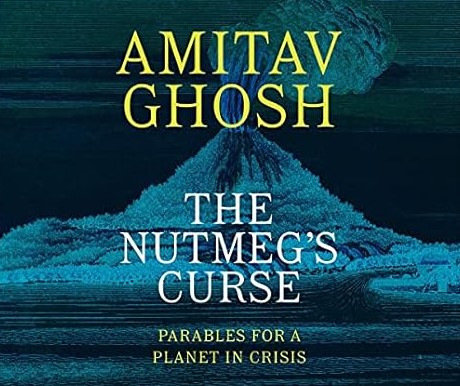Hanna Burr | Book Review of Amitav Ghosh’s The Nutmeg’s Curse: Parables
for a Planet in Crisis (Penguin Random House India, 2021)
◊ ◊ ◊
Amitav Ghosh’s The Nutmeg’s Curse is an intricate saga that ranges from historical stories about the colonization of the Banda Islands in the 17th century to predictions about the near future when climate change will cause geopolitical upheaval on a scale we have not yet imagined. Ghosh has applied his considerable narrative and investigative talents to the challenge of grappling with climate change. While he approaches the issue from multiple angles, Ghosh’s jumping-off point is the 1621 massacre and take-over of the Banda archipelago by Dutch colonists in pursuit of the precious spice nutmeg. Ghosh argues that the events that unfolded on the islands were symbolic of the broader interactions between imperialism, genocide, capitalism, and climate destruction that would continue to unfold across the world even to the present day. He asserts that the seed of today’s climate crisis was not merely the technological advent of the Industrial Revolution, but the development of the exploitative and inhumane ways of relating to indigenous populations, minorities, and the environment that developed during the early modern period. Ghosh even goes so far as to say that “colonialism, genocide, and structures of organized violence were the foundations on which industrial modernity was built” (Ghosh, 162).
Narrative is what drives Ghosh’s book. His argument moves so seamlessly between anecdotes that one hardly notices the wealth of well-researched facts and statistics woven into the detailed imagery. Rather than being confusing in its intricacy, his writing is articulate and powerful. Because of its popularizing flavor, the book is ideal for the educated layperson, or a graduate or undergraduate student of the environmental humanities. It is the perfect tool for introducing students to foundational questions about why people study the environment and how our relationship with the environment is deeply enmeshed with society and culture, forming a reciprocal relationship that informs our everyday existence.
In Chapters One through Seven, the first section of the book describes the origin of capitalist exploitation and the extraction of material goods and human labor. According to Ghosh, the ideology of capitalism evolved during violent colonial interactions between Europeans and indigenous populations around the world. Apart from the massacre of the Banda population, Ghosh also focuses on the Pequot War of the early 1600s, the first genocide of indigenous people in North America. For Ghosh, the way the Puritans sought to eradicate indigenous people, the memory of indigenous people, and the very ground on which they lived, is another illustration of the changing ways that “modern,” “advanced” Europeans were beginning to view the earth as inert, even as they began to view non-white, non-Christian peoples as mute, dumb “animals” in need of enslaving. Ghosh uses these anecdotes to demonstrate that the ecocidal act of taming nature, together with the genocidal act of eradicating “uncivilized” people—which combine into the broader violent tendency that Ghosh calls “omnicide”—have always been intrinsically linked with ideas of modernity. As Ghosh points out, these racially charged, religiously-justified attempts to purify the earth later morphed into liberal interventionism.
Before jumping into the 20th and 21st centuries, Ghosh returns to the Banda Islands to show how the Dutch’s all-encompassing desire to keep profits high caused them to embark on a centuries-long quest to destroy the nutmeg trees on all but a few select islands. This action further illustrated the “unrestrained excess that lies hidden at the heart of the vision of world-as-resource” (105).
After establishing the historical roots of these destructive geopolitical dynamics, Ghosh catapults us into the present, where coal and oil have become the new nutmeg. In chapters eight and nine, he explains how fossil fuels are deeply enmeshed with global power relations. The ultimate example of this is the petrol dollar, a pillar of the U.S. economy. The U.S. also maintains huge geopolitical advantages by protecting those “chokeholds” or geographic locations that oil must pass through as it is shipped from petrol states to nations all over the world. According to Ghosh, this advantageous power dynamic is one of the reasons why the U.S. and its powerful allies in the northern hemisphere have been sluggish to respond to the climate crisis.
In chapters eleven, twelve, and thirteen Ghosh reveals how vulnerable the U.S. and other “developed” countries really are to the current and future devastations of climate change and global turmoil by showing how these countries failed to adequately respond to the pandemic. In fact, the countries that western think tanks assumed would suffer and collapse under the stress of the pandemic were those that most successfully weathered the storm (184). Ghosh posits two reasons for this: One, the continued (subliminal) belief in Western (white) superior bodies decreased the sense of urgency and delayed action. The second reason is that huge concentrations of wealth delay action because those in power have access to incredible resources, but their poorer countrymen do not. These vulnerable populations within rich countries are therefore more likely to suffer than their equally poor but more-structurally protected fellows in countries with a less severe wealth gap.
This same counterintuitive effect of wealth gaps applies to the ever-more prevalent damage resulting from equatorial storms. Ghosh asserts that rich cities such as Houston, Mumbai, and Miami are generally constructed in more ecologically vulnerable places because wealth enables builders to significantly alter the terrain to suit the needs of the inhabitants. But this “strength” becomes a weakness in the face of natural disasters because the chaos and damage caused by these events eventually overwhelms man-made infrastructures (198). Both Covid 19 and storm damage reveal that “inequality is a far better indicator of the likely impacts of disasters than aggregate wealth” (195). Ghosh uses these chapters to further underscore the dangers ahead if the West continues to cling to the status quo and refuses to address its fundamentally imperialist and exploitative manner of interacting with landscapes and endangered populations of humans and animals.
The rest of the book is devoted to exploring “vitalist politics,” which is the solution Ghosh proposes for the environmental crisis. According to Ghosh, since the root of climate change is a toxic way of thinking about the environment, the antidote will stem first from a shift in mindset. He says we must listen to and emulate those individuals and communities who interact with the earth as Gaia: a living, sentient organism. Ghosh takes as his example the story of Davi Kopenaw, a shaman from the Amazonian rainforests of Brazil who wrote The Falling Sky, a “political memoir, polemic, autobiography, and compendium of knowledge” about life in the Amazon (280). Kopenawa approaches nature from the perspective of the xapiri, the spirits of the forest, and argues for greater environmental protections in the Amazon basin. Ghosh urges artists, writers, and filmmakers to embark on similar creative journeys to give voice to nonhuman entities. Ghosh hopes that a revolution in our way of thinking about the environment will have ripple effects throughout all our structural and cultural systems (278).
Ghosh’s conclusion lacks specific suggestions for addressing the climate crisis beyond the urge to change our cultural narratives. Despite its merits, this ephemeral suggestion is the weakest aspect of his book. For many readers, his meticulous-researched and well-constructed argument on the origins of the environmental crisis will be more easily swallowed than his suggestion that we learn to think of the earth as Gaia and her rivers and mountains as sentient beings. Only time will tell if this perspective is powerful enough to undo our current exploitative practices. Still, whether the reader agrees with his conclusion, Ghosh is a persuasive defender of the power of narrative and his historical analysis beautifully dissects the foundations of our modern, capitalist relationship with the land and her peoples.
Hanna Burr is a graduate of the MFA Program in Creative Writing and Environment at Iowa State University and the former visual arts editor of Flyway: Journal of Writing & Environment.




